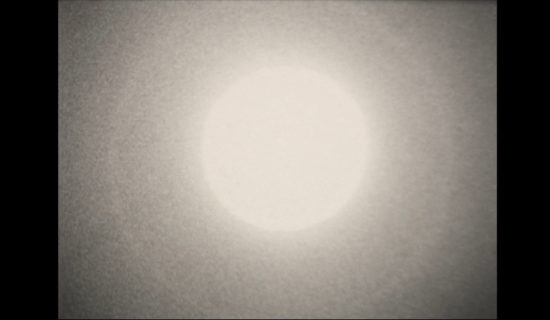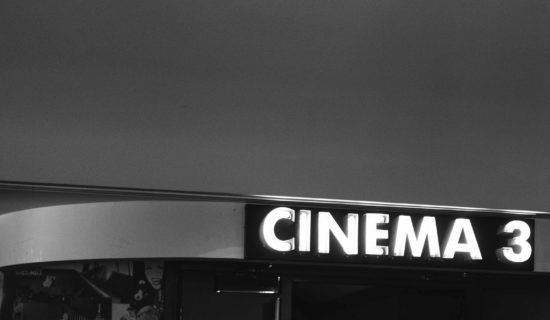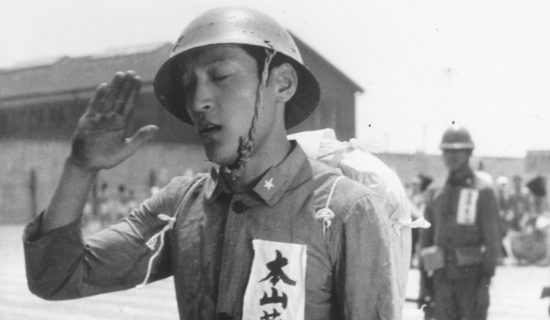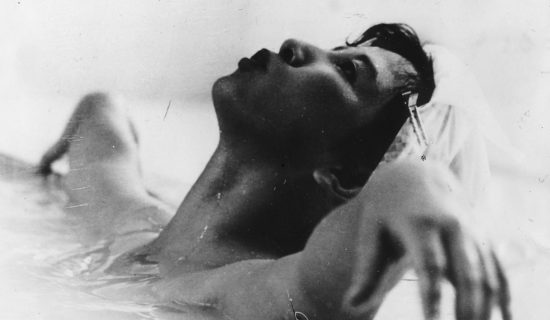After the talk on the Tremors of the Japanese New Wave, I take my seat in the Barbican theatre for Bad Boys (Hani, 1961) and Studio Sunrise (Aoki, 2017). Inspired by a passionate and detailed discussion about how post-war Japan tilted the lens of cinema toward protest and social commentary, I’m ready to take in a product of that age alongside a more contemporary avant-garde piece. The cinema is nearly full, as the screen illuminates to present Kioto Aoki’s Studio Sunrise.
A stop motion 35mm film written by Aoki begins the short film, thanking us for attending and briefly explaining what the film is about. It is a reflected self-portrait imitating the movements of the sun.
Studio Sunrise is practically a silent film. The cinema goes completely still apart from a few rumbling bellies in the audience, almost like a drum roll. It’s very bright, which I guess is emulating the brightness of the sun. It almost feels like those typical scenes in films where people see the light at the end of the tunnel.
The camera moves in a rotating motion, falling forward and then coming back round in a circle like a wheel rolling but staying in the same place. You tumble forward with it, in your mind. When the camera faces down, you see feet walking forwards. The camera is the filmmaker’s eyes.
Something comes into view, but the audience is not sure what. As it gets closer, we realise it’s a mirror. Then the filmmaker, with the camera up against her eye, comes into the mirror. She is reflected back. The end.

The curtains draw slightly narrower and Bad Boys begins.
It’s a black and white fictional film shot on 35mm in a documentary style using non-professional actors, handheld cinematography, and location shooting. The non-professional actors in this film were simply asked to be themselves and were not given a script.
The plot follows a young man who is seen as a bad influence by the parents of his friends.
Bad Boys blurs the lines between fiction and documentary. In a similar way to films like Fight Club (Fincher, 1999) and American Psycho (Harron, 2000), you can hear the protagonist’s thoughts. This makes an amusing contradiction between what the filmmaker is giving the audience and what the character within the film is thinking. This technique compels us to feel closer to the character in the film, as though we and the character are one.

The film is heavy criticism of the elite. It highlights the divisions in society. One stand-out moment for me is near the beginning where the group of boys plan to steal from a jeweler. The boys are outside the shop and the camera is inside the shop, looking out. The jeweler is full of pearls and expensive things, but the boys are outside emptying their pockets. Only one of them has a tiny amount of money. As the boys take the jewelry, they throw a flour bomb in the owner’s face, turning it completely white. It is a very harmless and childlike way of escaping a crime, which makes you feel all the more on the boy’s side.
There is a sense of irony between the boy’s behaviour and their actions. They pretend that one of them has been beaten up and that the one responsible for it is inside the cinema. They have no money to buy a ticket, so this is their way of attempting to go in. They emulate the behaviour of the characters in the film they want to see.

Throughout Bad Boys there are flashbacks, which often tell us a bit more about Hiroshi (the protagonist). These flashbacks happen more regularly after he is sent to a boy’s reform school. One striking flashback rewinds to Hiroshi as a young boy, trying to sell a pair of sunglasses to adults at a bar. Most people dismiss him, but one woman asks where he’s from and if he’s okay. She buys the sunglasses from him but also takes him back to her home. There she cares for him, gives him a bath, and feeds him. We now know that he hasn’t got any parents. When we return from the flashback, Hiroshi says in his thoughts, “I wonder what she’s doing now? Why was she so kind to me?” At this point, Hiroshi is very vulnerable emotionally.
During their time at the boy’s reform school, there is a poignant scene where the boys have the freedom to shout whatever they feel. They go to the water’s edge and chuck pebbles. “Let me out sooner!” and, “I’m starving” are a few of the things the boys shout. There are moments that beautifully capture the feelings of Hiroshi. He says, “everyone ‘cept me is free.” Then shortly after we see birds soaring up above – freedom. A melancholic juxtaposition.

A brutal scene sees Hiroshi ganged up on, getting told to run headfirst into a wall. He does it. At this point, it seems like he has become emotionally numb. After this scene, things start to get a bit better and he decides that things have to change. A few of the other boys gather with Hiroshi and plan a confrontation. He stands up to the bullies and gets into a fight. He then changes class and settles in the woodworking team with a great bunch of lads and a friendly teacher. He starts to realise that some people are there to look out for him. He sees the kindness in others around him. He is then released, the camera watching him walk through the gates. The whole time he is walking away, he walks between the bars. I think this is a reflection of him going on a straight and narrow path to a better life.

If you’d like to hear about more about Japanese New Wave Cinema, check out the JAEFF website here: jaeff.org








































